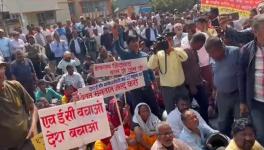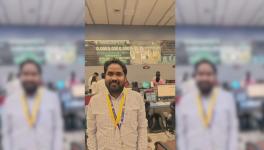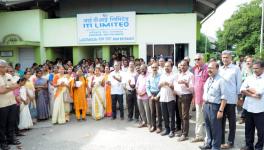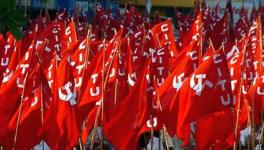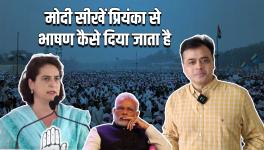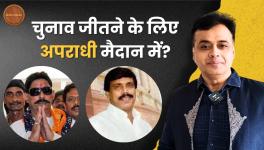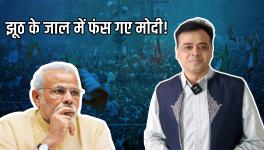'Traditional Puppeteers have to be Nurtured' Part I
In the first part of his conversation with Newsclick, celebrated puppeteer Dadi Pudumjee speaks of how his childhood hobby gradually grew into a passion for puppetry. He shares with us his Ahmedabad days, traveling abroad with the Darpana Puppet Group opening up his ideas of puppet theatre, challenges while working for ISRO's community TV programmes, not finishing his masters in NID and founding the Ishara Puppet Theatre Trust.

Transcript:
Pranav Brara (PB): Hello and welcome to Newsclick. Today we have India's leading puppeteer, also recepient of the Padmashree in 2011, Sangeet Natak Akademi Award in 1992, Sanskriti Pratishtan Award and Delhi Natya Sangh Award. He is also the President of UNIMA, which is the International Puppetry Association. He is Dadi Pudumjee. Welcome.
PB: I have seen a lot of your work. I have seen all those huge puppets that go on stage and entertain everyone around. When and how did you get influenced by this creative form? And what were your motivations, your influences, your inspirations, your support to really go for this art form and just express yourself as an artist?
Dadi Pudumjee (DP): You know last night, i was just laughing because someone asked me a similar question and a friend who was sitting next to me said, you know we heard this so often, this whole history of where you started, but i said, i can't help it, it's that question which everyone first asks me. I am from Pune. And it started as a hobby in childhood. I was given two string puppets. There was a company called Pelham Puppets in the UK and they used to make toy puppets and it started from there. So, that's one thing led to another. Pune had an excellent, before all these bookshops crossword and all, had a very famous bookshop called Manneys. It's a famous bookshop all over India. People used to travel to Pune to come to it and that bookshop had a shelf of theatre, art and things like that and very often puppet books would come in there, which today, infact you would not see in any of the bookshops and
And, so it was more self learning, it was a hobby, through school, through my college days, you did social, you know, charity shows, string puppets, playback music, musical things, collecting some small funds, 200-300 rupees for organisationsand then later on in 71, after my graduation in Poona, i went to Ahmedabad to study in the NID, National Institute of Design and Ahmedabad also had, has, the Darpana Akademi of Performing Arts , which at that point of time had a very active puppet section run by the late Meher...? So, in the evenings I was involved with them and the hobby became sort of more educated, codified. There you learnt about puppets, in fact, learnt a lot about Indian traditional puppets at that centre and travelled with them and i think it was 1972, with the Darpana Puppet group, we performed in Shille, Mar..,? 2 cities North of Paris, small towns. Today they are like the Edinburgh of puppetry. In September again will be the World Festival, every 2 years and its huge; from all over the world there are puppet companies, events take place and what i saw there from that on it totally opened up my ideas to puppet theatre. One thing led to another towards the end of an idea. In fact, in my last year, it was graphic design and then i was going into the film. 76 was ISRO – Indian Space Research Organisation and the SITE experiments – Satelite Instructional TV Experiment – where before TV was known too much in India, there was satellite and 6 or 7 states made programmes for hinterland, for rural areas, for community viewing sets and the Earth station was ISRO, Space Application Centre in Ahmedabad. So there was a programme called Insight which was a direct link in Gujarat, .. and we had a puppet serial running. I would say it was possibly one of the first attempted puppet serials for television, it was in black and white.
PB: What was the name of the serial?
DP: The serial was called Hoon and Haan – Hoon Bhai and Haan bhai ; matlab me and the other one is yes haan and one is the mukhi who was a well known actor, famous actor called Kailash Pandya and the alter ego was a donkey, a head over a fence and the voice of the donkey was a very very famous actor from Gujarat ..Sukhnayak... I think he passed away and there was a team which researched incidents, things which were happening, his family being children and adults. There was a director, V K Raina, a script writer and production and there were incidents which would happen, it was only 45 kilometres away. So, we'd find a story from anywhere in the world to fit that incident and these 2 main characters were constant every, i think, Tuesday and they would discuss and the man, the mukhi of the village wants to change but cant change its the social problem, the donkey says i dont care and he would say whatever he wants. So, we'd find a story from anywhere in the world to fit that situation and it would always be open ended because the donkey was the proletariat and the voice ... they had a serial, they had things, educational programmes whatever the live actor couldnt say or was sensitive used to come into the puppet serial and all sorts of things, incidents.. infact, it became so strong that very often, if it was critical, the actual, this is community viewing, we knew that if we said something very, what we wanted to say against the whoever was controlling things in the village, they pull out the fuses of electricity and that was another challenge to be able to say things, but in a certain way. First 2, 3 – i remember, programmes, the donkey, they said, this is the nakli donker, this is not the real donkey, you're trying to fool us; we said, obviously it is a puppet donkey, but then because of what the voice of the people was a donkey, there were huge things that would come to the studio towards the end of 30-31 programmes. There were wedding invitations, children would send gifts to the donkey, grain would come, anaj would come as a gift. So, it was like, it was quite interesting , so that's how one thing led to another.
PB: So, how old were you exactly when you took the decision of being a puppeteer and taking this throught out your life?
DP: I didn't; it happened in 1976. it was my last yera at NID. I'd made, there was no video at that point, the first , it was a film of course and 3 minute film on 35mm. That's what we did and shot and edit and all that and i just finished that and this project came and i was home for my holidays and they said it's a 1 year thing , so, obviously i wanted to do that but then you know it was your last year at NID – this that – NID understood and said we'll give you a leave of abscence for a year, you know, so that you can go and then come back, its ok and then i said suppose i dont, then one thing leads to another, they said its upto you, but we are giving you this window period and i didnt get back to NID. I never finished at NID in the end. And then the puppet thing carried on. There was huge exhibition of those puppets and i got a scholarship to be in Sweden, in Stockholm under a very famous puppet director Michael Mischke, who had started a Marionette Theatre Institute in 3 years. I was a guest student there for about a year and a half.
PB: I wanted to ask you about the body of work that you have done , which is a part of your artistic carrier. I have seen you perform socially active plays, talking about HIV, other social issues, going to schools and performing; I have also recently seen you creating a performanve of a very very old classsic play called Heer Ranjha which concluded the Ishara Theatre Festival in April. So, what is that one thing that really, in terms of the genre, in terms of the work and how do you see the puppets who you make and when they move, in what genre do you love them more or you love in every genre? Do you have a preference?
DP: Well, you see this, the way of looking at puppets or the way i'm working right now with scale, as you said, large puppets, small puppets, things like that, that came about in the period in Sweden, in Stockholm. Michael Mischke used to do a lot of adult theatre with puppets, scale, size things like that. That is where that influence comes from and in 1980, even before that there was a priod in East Berlin, but, when i came to Delhi and set up the puppet company which is called Sutradhar Puppet Theatre at Shriram Centre of Art and Culture, we used to perform every weekend – Saturdays and Sundays in the basement theatre and the idea was to do, take well known stories, folktales, epics, myths and present them in a different way so that was a possibly the first time we broke the conventional puppet, puppet stage; used the full stage, we used actors, we used sutradhar narrators, things like that. That has continued, but, within that, given that each performance, at least, i try to work on something else. Recently, i have noticed that in fact i have gone back to some of the older work that i had done and recreated that also in certain things, you know reworked on the look and style i would say. You were talking of social things - that every puppeteer in India, traditional or modern, at some point of time, has been working with educational themes. Our project you were talking about HIV was a UNESCO project which was i think 8 countries around the world were selected and in each country there was a group theatre, non formal education, we had 2 in India – one puppet company and an NGO working for women in Chennai and our thing was the first, 1 or 2 years was on HIV awareness, discrimination but using non-formal education, ours was using puppetry and also working with marginalised group and the group at that time which i was connected was Salamba lactras?, street children's programme and the first group of 18 year olds were going to come out and they want them to stand on their own feet so they were very interested in theatre, in movement. There was a boy called Kapil, Kaapil Dev. He's a very good puppeteer who had interned with us long ago and then he used to teach at SBT and today he's gone to Bombay. So, there was always some nucleus there. So, when these came out, 2 of them became professional photographers and there was a group of 5 people who joined Ishara in this programme who today have become professional puppeteers. And 2-3 went to television, Indian version of Sesame Street – Gali Gali Sim Sim. So that is where some of them are. Early work, there has always been educational work but one of the major things was the first Safdar Hashmi Festival after his death and that was a piece called Alegory on a peom by Randhir Khare, INdian poet who writes in English – failed to be human and we had done a piece, a half an hour piece with his poem, music. So always there has been some ..Even in the HIV and substance abuse in the same project, the idea was, the challenge was not only the message but giving social status to the people working – in this case – today they are no longer street kids and as well as – this group is not considered as street kids – the ones who are working with us; but also the medium and the message meet because these are all heavy messages and how can you put it across with some sense of humour, music, whatever which catches the audience in that 15-20 minutes, you know, they want to watch it. So the performances were made for bastis, community, schools, colleges. Then there were discussions which were used as a catalyst actually because in the area, there would always be a social worker or a councillor and that person he or she would question and take it forward.
PB: Ishara is now something that you founded. When did you start it?
DP: 1986 i left the Shriram Centre. I finished Sutradhara. I finished my contract with them. And that's when it started. You know, we started doing small shows, performances at the trade fair, things like that. TIE – the Times of India, the first thing we did was workshops in schools 40 minutes little things with puppets. So, it carried on there as a very fluid group. A lot of very well known people today – Puran Bhatt, fantastic traditional puppeteer, Rajasthani, worked with us at Shriram and then also worked. Vinod Dua, he was one of the script writers and puppeteers at Shriram Centre, Lodi Road. We are all lot of interested people who worked together and then the freelance work started with the project work – dancers, actors, you know. Nandita Das used to be with us, puppets. All sorts of people, friends and slowly that formalised into the Ishara Puppet theatre and in 2001 we got established as a trust, Ishara Puppet Theatre Trust, you know we got registered, things like that. It was the year also, we started our first international puppet festival.
PB: It is one of the only festival in puppet theatre that happened in the country
DP: Of, international festival, annual international festival. The very big one is the National Festival which the Sangeet Natak Akademi does every year called Putul Yatra and it happens in different cities, since i think, since 2003 almost every year they've been having exhibition or a puppet festival, national festival in different states.
Get the latest reports & analysis with people's perspective on Protests, movements & deep analytical videos, discussions of the current affairs in your Telegram app. Subscribe to NewsClick's Telegram channel & get Real-Time updates on stories, as they get published on our website.









